Vegan Pozole
I invite you to discover an authentic Mexican culinary experience with the vegan pozole recipe. This delicious dish combines rich flavors and complex textures to give you a memorable taste sensation. So, prepare your taste buds for a culinary journey full of flavor with this vegetable version of a Mexican classic.
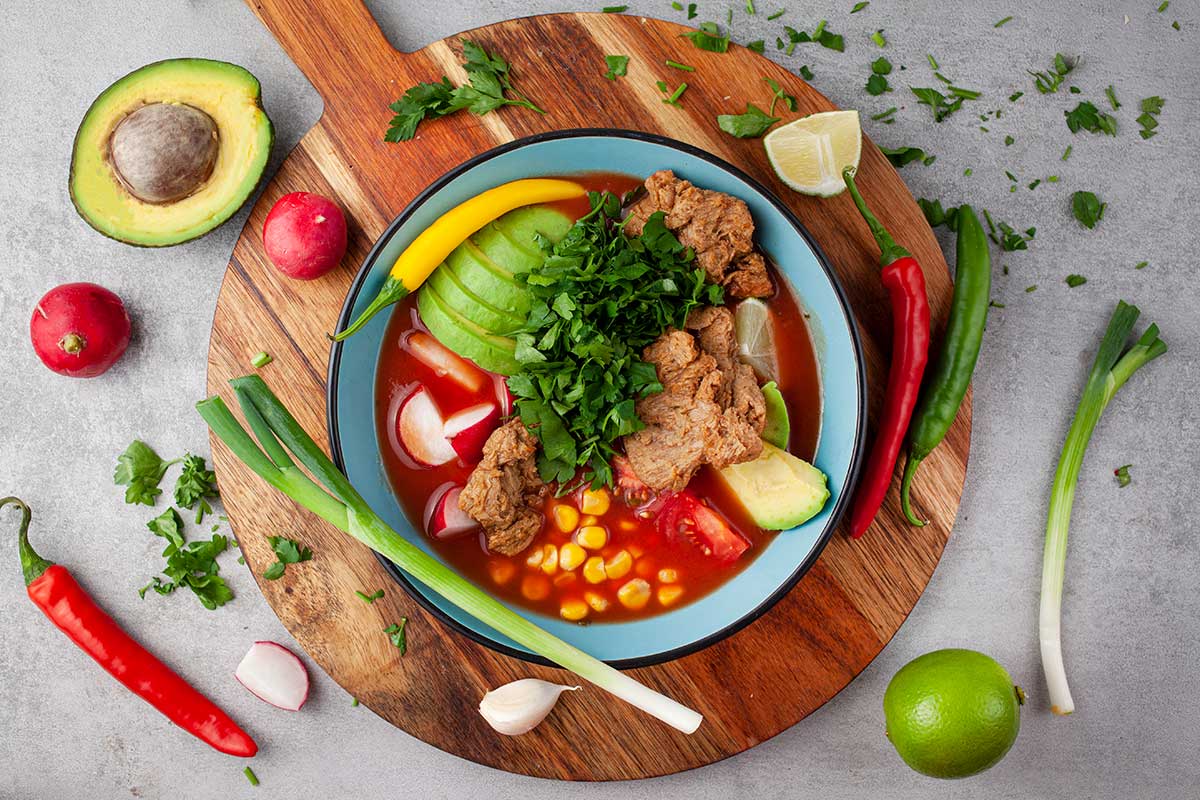
I love Mexican cuisine and I get excited every time I get the urge to test new Mexican recipes. So, today I tried the classic Mexican recipe – pozole – but in the vegetarian version. I hope you enjoy!
If you are looking for other Mexican recipes, try:
- Mexican Breakfast Casserole
- Mexican Stuffed Peppers
- Mexican Spaghetti (Veggie Taco Spaghetti)
- Mexican Quinoa
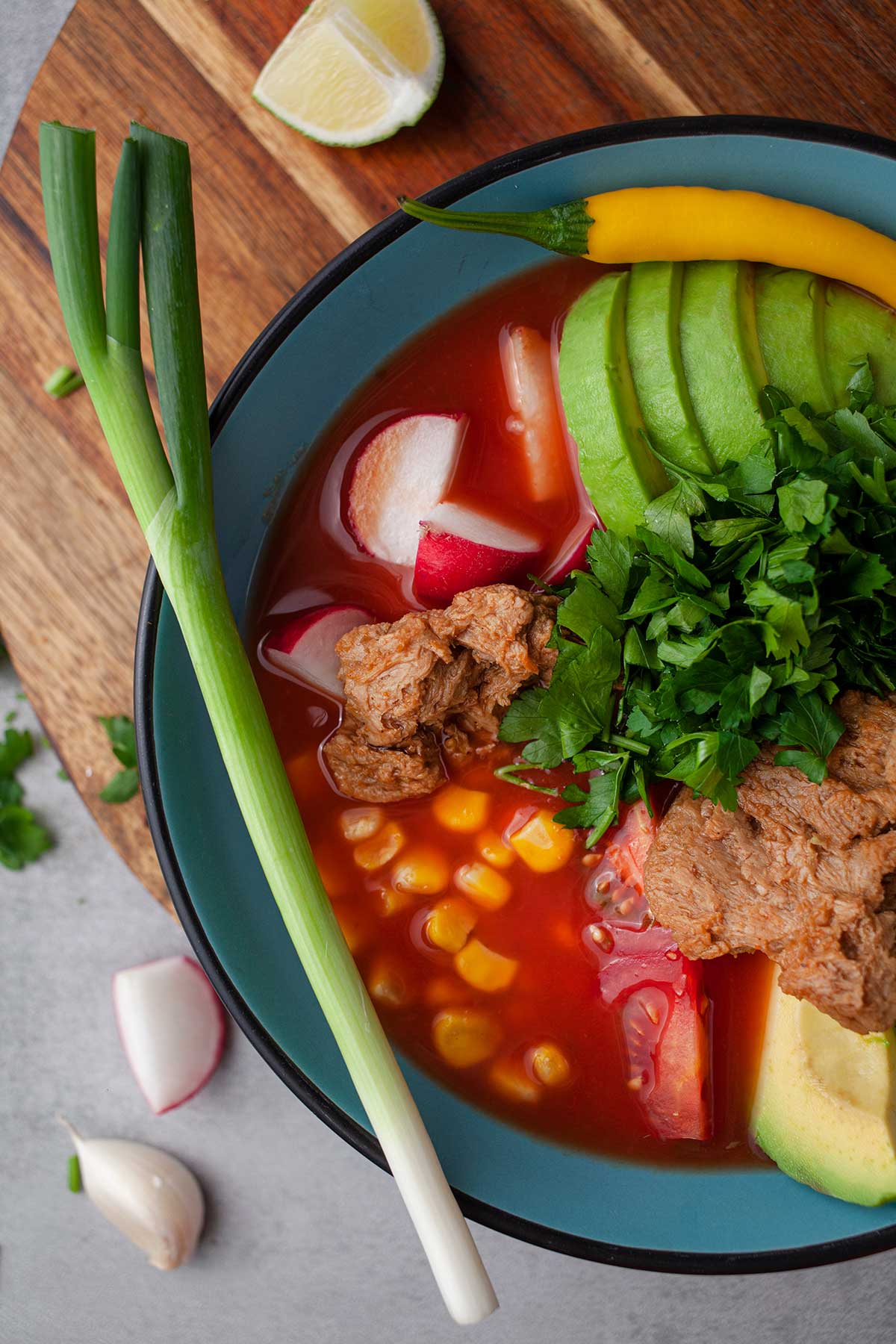
Origins and history – authentic Mexican Pozole recipe
Pozole is a traditional dish from Mexican cuisine, with origins deeply rooted in Aztec and Mayan culture. This culinary preparation has a rich history and special meanings for various communities in Mexico. Here is more information about its traditional origins and preparation method:
Origins and meaning:
The word “pozole” comes from the Nahuatl language, spoken by the Aztecs, and means “foamy soup.” In pre-Hispanic times, pozole was considered a sacred food and was associated with religious rituals.
Traditional ingredients:
The traditional pozole recipe involves the use of pork, chicken or beef, but there are also vegetarian or vegan versions of pozole. Basic ingredients include hominy (nixtamalized white corn), meat or vegetarian alternatives, chile, onion, garlic, spices and garnishes such as shredded cabbage, lemon or lime wedges, avocado and dried oregano.
Method of preparation:
The preparation process begins by boiling the meat (or the vegan alternative) together with the hominy in a mixture of water and soup or vegetable stock. Spices are added, including dry or fresh chiles, to give the pozole its characteristic flavor and sweetness. The pozole is cooked on low heat until all the flavors mix and the meat becomes tender.
Serving:
Pozole is served hot and garnished with chopped cabbage, lemon or lime wedges, avocado, burdock root and dried oregano. It is often served in large plates or cups and can be eaten as a full meal or as a soup dish.
Thus, pozole has a rich history and deep cultural meanings in Mexico. Over time, numerous variations of the recipe appeared, including vegan or vegetarian versions to suit modern dietary preferences.
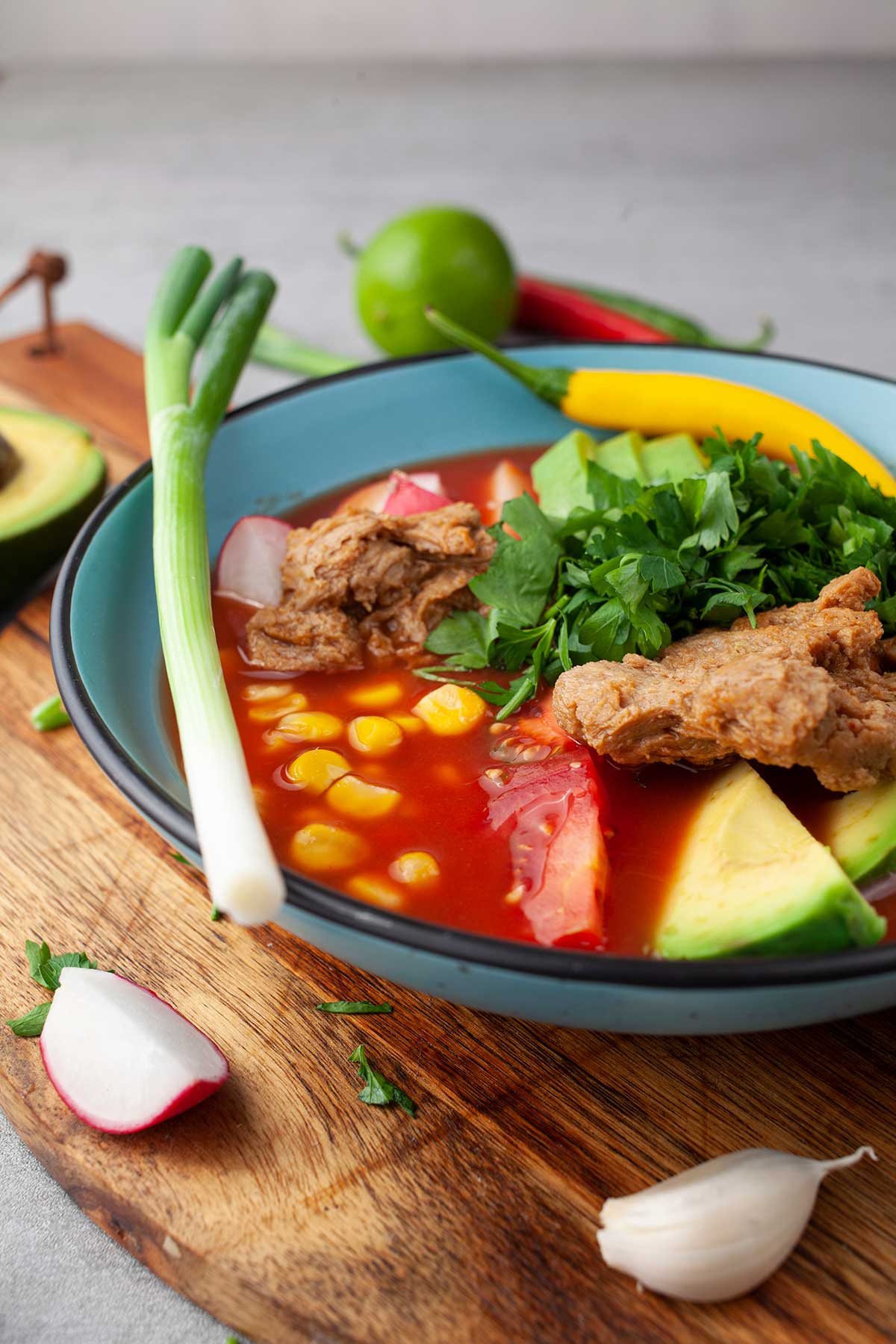
Traditional pozole recipe vs. the modern version
The traditional Mexican pozole recipe is often prepared with meat, especially pork, but other types of meat can also be used, such as chicken or beef. Here’s how the traditional recipe compares with the modern and vegan version:
Traditional pozole recipe:
- Meat: Meat is an essential ingredient in the traditional pozole recipe. This can be pork, chicken or beef, and sometimes several types of meat are used.
- Consistency: The traditional pozole recipe has a dense and rich consistency, with the meat adding an intense flavor and texture.
- Juiciness: The juiciness of traditional pozole often comes from dried or fresh chiles added during cooking.
- Traditional garnishes: Chopped cabbage, lemon or lime slices, burdock root, avocado and dried oregano are the traditional garnishes used to add freshness and complexity to the taste.
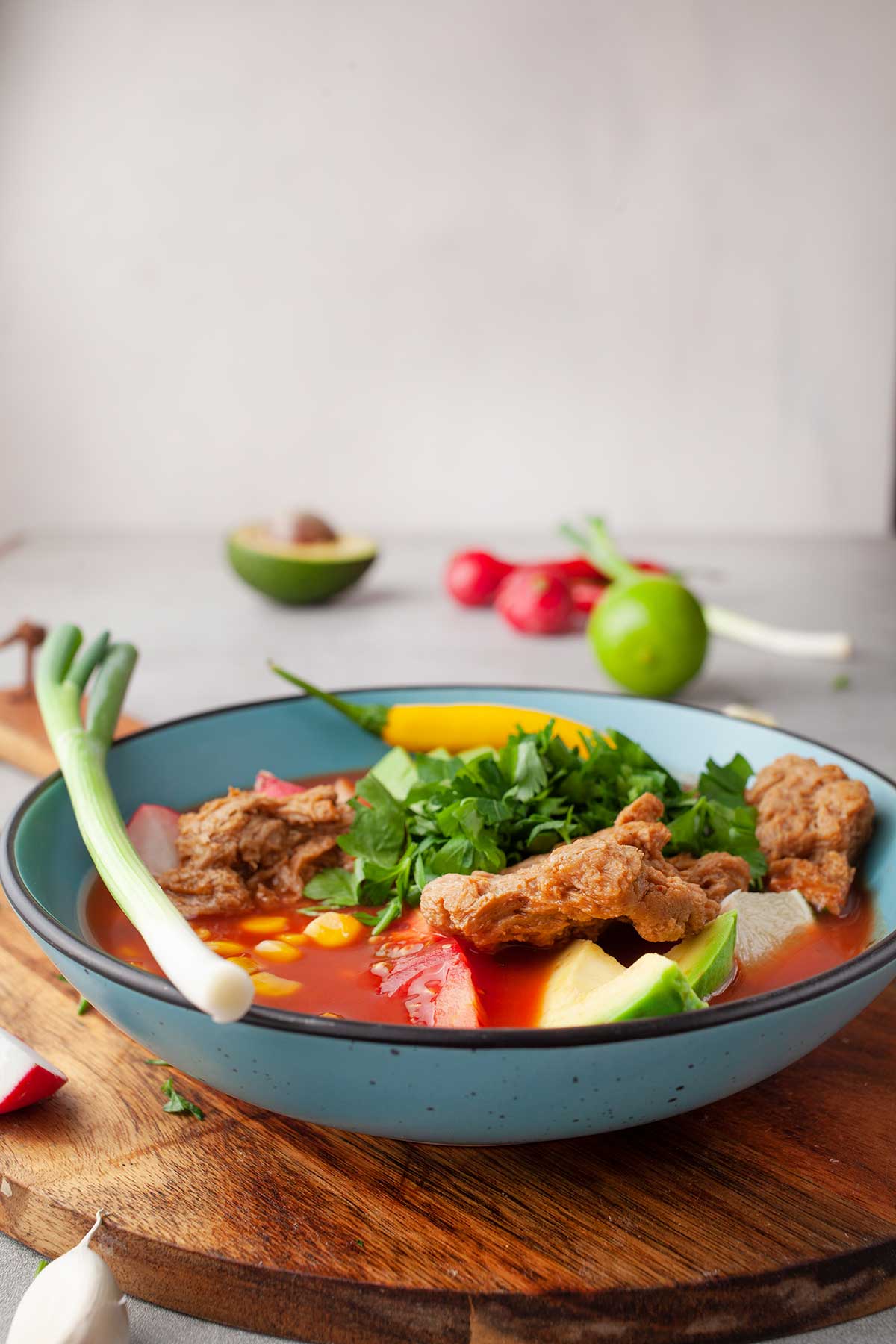
The modern and vegan version of pozole:
- Alternative meat: Instead of meat, the modern and vegan version of pozole usually uses vegetarian or vegan alternatives, such as textured soy, tofu or mushrooms. These alternatives can provide a similar texture and delicious taste.
- Consistency: The vegan version of pozole can have a consistency similar to that of the traditional recipe, but without meat.
- Spiciness: Spiciness can be adjusted according to preferences, adding more or less chile or other spicy spices.
- Various garnishes: The garnishes for the vegan pozole can include the same elements as the traditional recipe, such as cabbage, lemon, avocado and oregano. However, there are also creative options to add freshness and flavor, such as cilantro, chopped green onions or corn chips.
The vegan version of pozole can satisfy the tastes of those who prefer a meat-free alternative, but still want to enjoy the authentic flavors of Mexican cuisine. It is a delicious and healthy option for all Mexican food lovers.
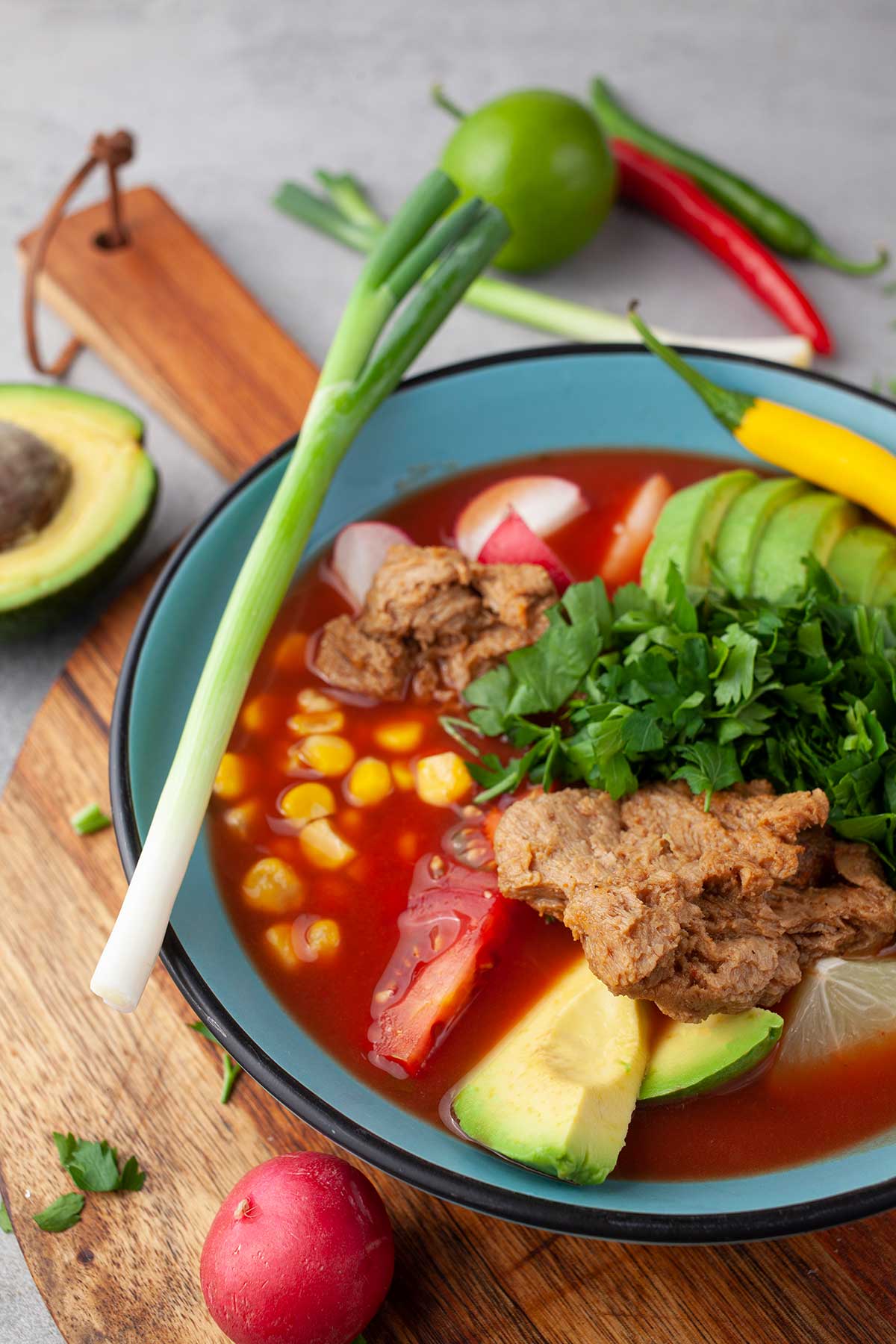
Vegan pozole verde vs. vegan pozole blanco vs. vegan pozole rojo
The primary difference between Vegan Pozole Verde, Vegan Pozole Blanco, and Vegan Pozole Rojo lies in the type of chili pepper used for their respective broths, which leads to variations in color, flavor, and spiciness:
Vegan Pozole Verde:
“Verde” means green in Spanish, and this pozole variant gets its name from the green chili peppers used in its preparation. It typically includes ingredients like tomatillos, green chili peppers (such as jalapeños or serranos), and green herbs like cilantro. The resulting broth is greenish in color and has a bright, fresh, and slightly spicy flavor.
Vegan Pozole Blanco:
“Blanco” translates to white, and this pozole features a clear or white broth. It is usually made without any chili peppers, so it’s not spicy. The primary ingredients are hominy, vegetable broth, and various aromatic seasonings like garlic, onions, and sometimes epazote. The flavor is mild and savory.
Vegan Pozole Rojo:
“Rojo” means red, and this pozole is known for its red-colored broth and robust flavor. It’s made with red chili peppers, such as guajillo, ancho, or pasilla, which give it a rich, smoky, and mildly spicy taste. In addition to hominy, it often contains tomatoes, garlic, and spices like cumin and oregano.
While the base ingredients (hominy and vegetable broth) are similar in all three variations, the choice of chili peppers and additional seasonings is what sets them apart. Depending on personal preference for spiciness and flavor profile, one can choose between Vegan Pozole Verde, Vegan Pozole Blanco, or Vegan Pozole Rojo.
Vegan pozole recipe
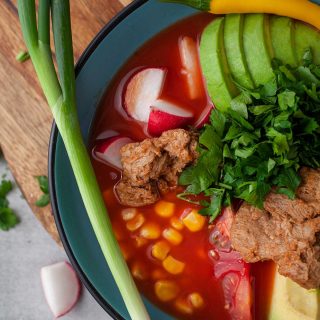
Vegan pozole
Ingredients
For the base sauce:
- 3 cups water
- 30 g dry hot pepper guajillo type
- 4 cloves garlic
For the pozole soup:
- 4 liters 135 floz vegetable stock
- 2 tablespoons olive oil
- 200 g 7 oz textured soy protein patties, dry
- 4 cloves garlic chopped
- 500 g 17.6 oz hominy white corn, drained (alternatively, use canned corn)
- 3 bay leaves
- 1 teaspoon ground cumin
- 1 tablespoon dried oregano
- salt and pepper to taste
Vegetables for pozole:
- ½ small white cabbage chopped
- 1 bunch parsley chopped
- 1 bunch coriander chopped
- ½ white onion sliced
- 2 avocados sliced
- 2 limes cut into 4
- 6 red radishes cut into 4
- 1 bunch green onion
- 10-15 cherry tomatoes
Instructions
- In a large pot, heat 4 liters of vegetable broth over medium heat.
- In a separate pan, lightly toast the hot peppers over low heat for a few minutes until they become slightly soft.
- Boil 3 cups of water in another pot and add the hot peppers to the boiling water. Cover with a lid and allow them to soak for 10-15 minutes.
- In a separate pan over medium heat, heat 2 tablespoons of olive oil. Add 4 cloves of minced garlic and sauté until the garlic turns golden.
- Transfer the rehydrated textured soy protein to the pot with the soup. Also, add the drained white corn, bay leaves, ground cumin, dried oregano, and salt.
- Bring it to a boil, then let it simmer on low heat for an additional 15 minutes.
- While the soup is simmering, prepare the base sauce. In a food processor, combine the soaked hot peppers and 4 cloves of garlic. Gradually add the water from soaking the peppers and blend until you achieve a creamy consistency. Strain this mixture through a sieve into the pot with the soup.
- Allow the soup to simmer for another hour.
- To serve, divide the chopped vegetables among bowls, pour the hot soup over the vegetables, and garnish with fresh herbs. Enjoy!
If you make this, please leave a review and rating if you liked this recipe! ★★★★★



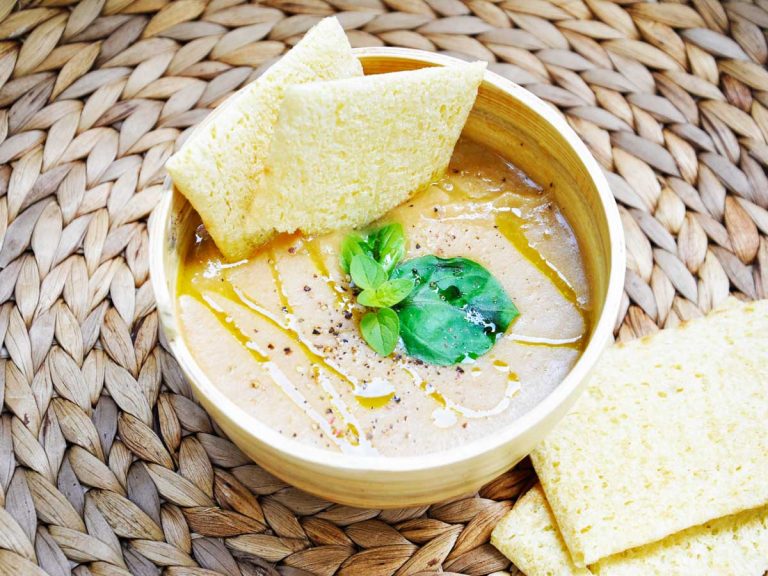

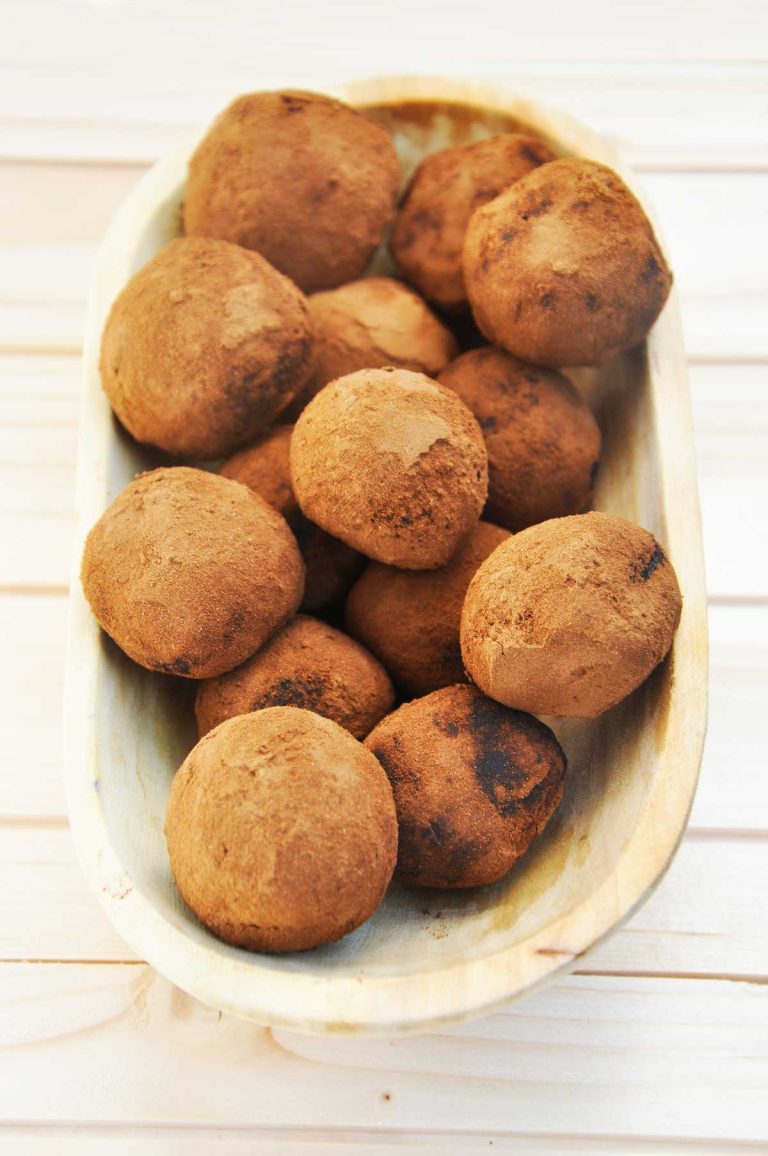

Great flavors!